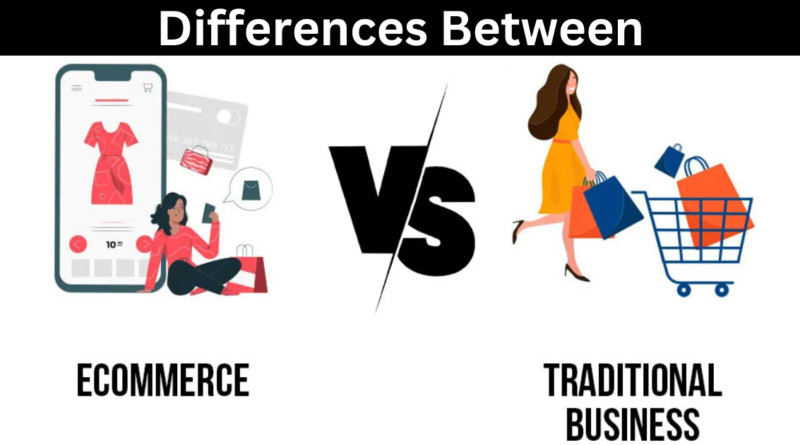Differences Between E-commerce Store and a Traditional Business
Introduction to E-commerce Store and Traditional Business
The differences between an e-commerce store and traditional businesses are many as Technology and the internet have revolutionized business operations over time. Two popular modes of conducting modern-day commerce include e-commerce stores and traditional brick-and-mortar businesses; both serve the purpose of selling goods or services but differ significantly in many respects; in this article, we’ll examine both types of entities by exploring their key characteristics as well as outlining potential advantages or disadvantages of each one.
What is an E-commerce Store?
An e-commerce store is an online virtual platform that enables businesses to sell products or services online. E-commerce stores typically utilize robust website infrastructures with secure payment gateways for transactions. They provide customers convenient browsing through products, product descriptions, and images and purchasing from within their home environment – offering global reach with global scalability.
An e-commerce store’s primary benefit lies in its 24-hour operation without physical store hours, making purchases possible anytime and increasing sales potential. Furthermore, online shops tend to have lower overhead costs than traditional businesses since there’s no need for storefronts, extensive inventory management or large teams of employees, making this option attractive for entrepreneurs with limited funds seeking a start-up venture.
What is a Traditional Business?
This refer to any physical establishment operating from its location and offering customers products or services in person. Traditional businesses have long been the cornerstone of commerce, providing tangible interactions and personal experiences for customers while typically requiring significant investments such as leasing or purchasing a commercial space, hiring employees, and managing inventory.
These businesses provide many advantages for local communities. Physical businesses can establish relationships with customers face-to-face and offer personalized experiences. Furthermore, traditional businesses allow customers to take products home right after purchase – something which may make the sale of certain types of products especially compelling.
Key Differences Between an E-commerce Store and a Traditional Business
Now that we understand the basic differences between online stores and traditional businesses let’s investigate some key distinctions:
Physical Presence:
One of the key differences between traditional businesses and e-commerce stores lies in their physical presence. While online stores operate entirely via virtual channels, traditional ones offer physical locations for customers to visit.
Operating Hours:
E-commerce stores enjoy the advantage of being open 24/7, giving customers access to purchase anytime, unlike traditional businesses that typically operate with set operating hours that limit customer access.
Overhead Costs:
E-commerce stores usually have lower overhead costs than traditional businesses since they don’t need physical storefronts, extensive inventory management systems, or large teams of employees for operations.
Global Reach:
E-commerce stores can have the ability to reach a global customer base; customers from anywhere can access and make purchases from your site; this contrasts with traditional businesses, which may only have access to local customers until expanding across multiple physical locations.
Personal Interaction:
Traditional businesses enjoy face-to-face customer interactions, enabling owners to form meaningful relationships and provide personalized experiences. At the same time, e-commerce stores depend on effective website design and customer service to create positive customer experiences.
Pros and Cons of Running an E-commerce Store
Now, let’s examine both sides of running an e-commerce store:
Pros
Flexibility:
Operating an e-commerce store allows entrepreneurs greater freedom regarding working hours and location; their business can be managed from any internet-enabled location worldwide.
Scalability:
E-commerce stores boast the advantage of being easily scalable, as they can respond to sudden increases in customer demand without significantly altering infrastructure. This makes expanding and reaching a wider customer base simpler than ever.
Lower Costs:
As previously discussed, e-commerce stores generally have lower overhead costs than traditional businesses due to no need for physical storefronts, extensive inventory management or large teams of employees – leading to cost savings for each enterprise.
Cons
Ongoing Competition:
The e-commerce industry is highly competitive, with numerous businesses competing for customer attention. Standing out from the pack and drawing customers in can be challenging.
Technical Challenges:
Running an e-commerce store requires both technical knowledge and expertise. From website development to secure payment gateways, entrepreneurs must possess an in-depth knowledge of this complex ecosystem of technologies.
Establishing Trust:
Convincing customers that an online platform is trustworthy can take time and effort. They may have concerns about the security of their personal information or product quality that can reduce sales.
Pros and Cons of Operating a Traditional Business
Now let’s consider the advantages and disadvantages of operating a traditional business:
Pros
Established Presence:
Traditional Businesses have the advantage of being familiar and providing customers with personal service by being physical establishments. Customers frequently prefer this kind of relationship.
Immediate Gratification:
Traditional businesses provide instant gratification for customers by immediately offering products they want, browsing, making purchases, and taking them home without waiting for shipping.
Interpersonal Interaction:
Traditional businesses benefit greatly from face-to-face customer engagement; this helps form long-lasting relationships and results in satisfied customers who appreciate offering personalized experiences.
Cons
Higher Overhead Costs:
Established businesses often incur higher overhead than e-commerce stores, including rent, utilities, inventory management fees and employee salaries.
Limited Reach:
Traditional businesses tend to serve only localizers if they expand into multiple physical limiting growth potential compared with online stores with global reach.
Operating Hours:
Traditional businesses usually set specific operating hours that limit customer access outside these hours and could result in missed sales opportunities.
Transitioning from a Traditional Business to an E-commerce Store
As technology develops and consumer shopping preferences shift towards online purchases, many traditional businesses are exploring transitioning into an e-commerce model. Although this transition may prove challenging at first, its numerous benefits, such as expanded reach and reduced overhead costs, make it worthwhile. Here are some key steps for transitioning a traditional store into an e-commerce store:
Market Research:
Conduct extensive market research to understand the demand for your products or services in the online marketplace. Take care in analyzing competitors, target audience demographics and potential entry barriers.
Website Development:
Invest in professional website development services to create a user-friendly and visually appealing e-commerce store, complete with secure features that are responsive and optimized for search engines.
Inventory Management:
Implement effective inventory management systems to maintain accurate stock levels and stream fulfilment, perhaps using third-party fulfilment services for improved operations.
Marketing and Promotion:
Create a comprehensive marketing and promotion plan to draw customers to your e-commerce store, using SEO techniques, social media promotion, and targeted advertising to reach your desired demographics.
Customer Service:
Prioritize outstanding customer service to build trust and loyalty among your online customers. Use live chat support, easy returns/exchanges processes and proactive communication to enhance the customer experience.
The Future: E-commerce vs Traditional Business
E-commerce is unquestionably revolutionizing commerce. The convenience, affordability, and global reach of online stores are drawing more consumers each day, but this does not spell the end for traditional businesses; physical establishments still provide tailored experiences with immediate gratification.
Future predictions indicate a harmonious coexistence between online storefronts and traditional businesses as more firms embrace an omnichannel strategy combining their physical presence with online platforms to reach more customer preferences. This hybrid model allows businesses to take advantage of both forms of shopping experiences for consumers – providing seamless experiences.
The challenges of traditional business
Traditional businesses possess various advantages in today’s business landscape; however, they also face unique obstacles. Some of these challenges include:
Increased Competition:
Traditional businesses face fierce competition from e-commerce stores that provide lower prices and greater convenience, which makes attracting customers difficult in such an oversaturated marketplace.
Rising Costs:
Traditional businesses tend to incur greater operating expenses than online stores, including rent, utilities, and employee salaries, which can considerably affect profitability.
Limited Reach:
Traditional businesses are usually limited to serving their local customer base if they have multiple physical locations, which limits growth potential and makes entering new markets difficult.
The challenges of an E-commerce store
E-commerce stores present many advantages but also present their own challenges. Some examples include:
Competition and Saturation:
E-commerce stores face fierce competition for customer attention online, and standing out from the pack and attracting new clients may prove challenging.
Technical Expertise:
Running an e-commerce store requires technical savvy. From website creation and management to safe payment gateways, entrepreneurs must fully understand all technologies involved.
Establish Trust:
Establishing trust with customers online can be challenging. Customers may need help with the security of their personal information or product quality, which could impede sales.
Conclusion
The differences between an e-commerce store and traditional businesses are many. Each model offers distinct advantages and disadvantages, so entrepreneurs should consider their specific goals and target audience before deciding. E-commerce stores provide global reach with lower overhead costs; traditional businesses provide a personal touch and immediate gratification; however, as commerce evolves into the future, both models will likely be combined as businesses adopt an omnichannel strategy to address diverse consumer preferences. Entrepreneurs should embrace and capitalize upon each model for sustained success in an increasingly competitive business landscape.




